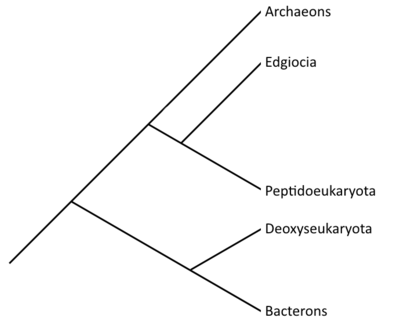Saunvare
Saunvare is a planet with life, but is uninhabitable by humans except for on high peaks. Its temperatures are very warm compared with Earth, with an average global temperature around 51 degrees Celsius (124°F). Most of its life is bizarrely unlike our own, with a variety of adaptations to the extreme global heat.
Contents
Climate
Lifeforms
Domains
Saunvare has five main domains of life, two of which have multicellular creatures within them. A very large split is present in lifeforms on Saunvare, being divided into DNA-using life and PNA-using life. They live mostly in seclusion from each other, giving Saunvare the appearance as if it is two different planets in one.
Bacterons
All bacterons are unicellular, have few organelles, and use DNA to code genetic information. They are generally small, simple cells which live mainly high in the atmosphere, on mountain peaks, and in polar regions due to the temperatures of the tropics being so high as to denature DNA, especially in deserts. A few species of bacterons can function properly with single-stranded DNA, but they have much smaller genomes than those with double-stranded DNA.
They often have few proteins but these proteins are consistent across species as they are used in processing waste. In place of many proteins, they use much smaller molecular structures or RNA segments. These proteins are often only several times larger than the molecules they manipulate, called proteinettes. They exist in a variety of environments toxic to all higher life on Saunvare and are the main source of Saunvare's large proportions of methane in its atmosphere.
Methanogenic Bacterons
The group of bacterons that generates the majority of the methane that resides in Saunvare's atmosphere relies on oxygen-poor environments as the majority of them are devastated by oxygen. They generate methane as a waste product, readily releasing it into their environment. They are some of the simplest and oldest lifeforms on Saunvare, and some of them are photosynthetic.
Edgiocia
Pronunciation: (English Phonetic: e-jē-'ō-kē-uh IPA/GA: ɛdʒiː'oʊkiːə). The edgiocia domain uses PNA to store genetic information and reproduces by asexual reproduction. All edgiocia organisms are unicellular and contain no organelles. They can live anywhere in the world due to the stable nature of PNA, and are common in the guts of peptidoseukaryotes. Lacking the protein-forming ribosomes, they simply convert their PNA into RNA in order to transcribe it into proteins in the normal cell environment.
Peptidoseukaryota
Genetic information in peptidoseukaryota is carried by PNA. These cells often have more organelles than archaeons and bacterons, but some species do lack organelles, especially those more adapted for parasitism. Peptidoseukaryota contains almost all multicellular life on Saunvare, containing all photosynthetic multicellular creatures along with several other kingdoms, some of which have photosynthetic clades within them. They are the most common in the tropics and in the oceans and are often more dependent on water than deoxsyeukaryota.
Deoxyseukaryota
Deoxyseukaryota uses DNA to carry genetic information, the equivalent of bacterons. Their forms between the northern and southern hemisphere are wildly different, especially for those who cannot fly. Their cells are often much larger than peptidoseukaryotae with larger genomes, but they are limited in their distribution. A number of them are multicellular creatures. They are much less numerous than peptidoseukaryota and mainly occupy polar regions and the air.
Solar System
The Heavna system consists of <x> planets. It is a highly enriched system which had a great deal of planet-forming materials in its protoplanetary disk, resulting in today's enormous rocky planets and gas giants with comparatively large rocky cores.
Planets
- Saunvare
- Peoria
